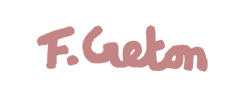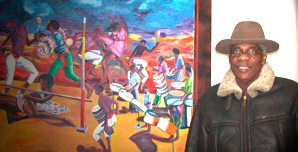Introduction
In the 2009 Black History month activity organised by CACOEU on Saturday 18th October at Goldsmiths College, London University, the internationally known Surinamese-Dutch painter Frank Creton displayed his paintings by a power point presentation that consisted of 37 images. The audience was confronted with the vast variety of themes and used techniques. From still life to chalk. From slave history to funeral rituals and ceremony.
Frank Creton said that his art objective is to paint the socio-cultural history of Suriname.
He wants to teach the viewer the vast and complex history of Suriname through his art work. And if he or she approaches the paintings with an open mind he or she will (re)discover the complex socio-cultural history of the Caribbean and thus preserve the cultural history.
This preservation of the cultural heritage takes place on several levels:
First, he identifies customs, manners and resistance situated in a certain time frame.
Second by painting urban and rural areas he informs the world about the material heritage of Suriname.
The same goes for painting women in kotomissie (traditional dress) and anigisa (headscarf), funeral rituals, et cetera.
Thirdly, the paintings by themselves are already part of the body of Surinamese cultural heritage in general and in particular of the Surinamese as well as Dutch art history.
Who is Frank Creton?
Frank Creton was born on 20th December 1941 in the district of Nickerie in Suriname.
Although Suriname, just as Guyana and French Guyana lay on the mainland of Latin America, they belong in social and cultural historical perspective to the Caribbean. The same goes for some regions of the Spanish speaking countries such as Columbia, Venezuela et cetera. He was raised in the district of Coronie. The districts Coronie and Nickerie lay in the Western part of Suriname. Nickerie with its Corantijn river forms the border between Suriname and Guyana. Nickerie is a rice disctrict. And Coronie is known for its coconut trees, honey and rice.
In many of his paintings Frank Creton tries to regenerate and relive his memories of rural Coronie with its typical houses and street scenes. His talent for drawing was discovered in his youth when he would sell his drawings for two cents a piece. After his primary school education he moved to Paramaribo the capital of Suriname for further education.
In 1962 Creton moved to Holland when he was 21 years of age. He did a variety of jobs including working as a sailor in the Dutch Merchant Navy. He then settled in Germany from 1962-1964 where he lived and worked as a canvasser selling door to door German books and magazines.
Upon returning to Amsterdam, Frank Creton took the decision to live fully for his art. He enrolled at the Volksuniversit (Adult Education Centre) Amsterdam and took private lessons from Martin Krabbe in anatomical proportion and the knowledge of colour. Frank Creton has built up an oeuvre which consists mostly of oil paintings.
He has had exhibitions in Paramaribo, Suriname, Cuba, the United States of America, Holland and in many other countries. His last international exhibition was part of a group exhibition by Dutch painters at the Biennale Internazionale Dell Arte Contemporanea 2005, Quinta Edizione in Florence Italy.
A large proportion of his works are in private, state and commercial collections. One of the biggest collectors of Frank Creton's art, with a permanent exhibition of his work in their New York based art Gallery, is the ING Bank in Holland.
Mr Creton has kindly given CACOEU permission to print some of his paintings in this issue of CACOEU TALK.
Frank L. Creton
Surinamese Artist
by: Jules RijssenIntroduction
In the 2009 Black History month activity organised by CACOEU on Saturday 18th October at Goldsmiths College, London University, the internationally known Surinamese-Dutch painter Frank Creton displayed his paintings by a power point presentation that consisted of 37 images. The audience was confronted with the vast variety of themes and used techniques. From still life to chalk. From slave history to funeral rituals and ceremony.
Frank Creton said that his art objective is to paint the socio-cultural history of Suriname.
He wants to teach the viewer the vast and complex history of Suriname through his art work. And if he or she approaches the paintings with an open mind he or she will (re)discover the complex socio-cultural history of the Caribbean and thus preserve the cultural history.
This preservation of the cultural heritage takes place on several levels:
First, he identifies customs, manners and resistance situated in a certain time frame.
Second by painting urban and rural areas he informs the world about the material heritage of Suriname.
The same goes for painting women in kotomissie (traditional dress) and anigisa (headscarf), funeral rituals, et cetera.
Thirdly, the paintings by themselves are already part of the body of Surinamese cultural heritage in general and in particular of the Surinamese as well as Dutch art history.
Who is Frank Creton?
Frank Creton was born on 20th December 1941 in the district of Nickerie in Suriname.
Although Suriname, just as Guyana and French Guyana lay on the mainland of Latin America, they belong in social and cultural historical perspective to the Caribbean. The same goes for some regions of the Spanish speaking countries such as Columbia, Venezuela et cetera. He was raised in the district of Coronie. The districts Coronie and Nickerie lay in the Western part of Suriname. Nickerie with its Corantijn river forms the border between Suriname and Guyana. Nickerie is a rice disctrict. And Coronie is known for its coconut trees, honey and rice.
In many of his paintings Frank Creton tries to regenerate and relive his memories of rural Coronie with its typical houses and street scenes. His talent for drawing was discovered in his youth when he would sell his drawings for two cents a piece. After his primary school education he moved to Paramaribo the capital of Suriname for further education.
In 1962 Creton moved to Holland when he was 21 years of age. He did a variety of jobs including working as a sailor in the Dutch Merchant Navy. He then settled in Germany from 1962-1964 where he lived and worked as a canvasser selling door to door German books and magazines.
Upon returning to Amsterdam, Frank Creton took the decision to live fully for his art. He enrolled at the Volksuniversit (Adult Education Centre) Amsterdam and took private lessons from Martin Krabbe in anatomical proportion and the knowledge of colour. Frank Creton has built up an oeuvre which consists mostly of oil paintings.
He has had exhibitions in Paramaribo, Suriname, Cuba, the United States of America, Holland and in many other countries. His last international exhibition was part of a group exhibition by Dutch painters at the Biennale Internazionale Dell Arte Contemporanea 2005, Quinta Edizione in Florence Italy.
A large proportion of his works are in private, state and commercial collections. One of the biggest collectors of Frank Creton's art, with a permanent exhibition of his work in their New York based art Gallery, is the ING Bank in Holland.
Mr Creton has kindly given CACOEU permission to print some of his paintings in this issue of CACOEU TALK.

